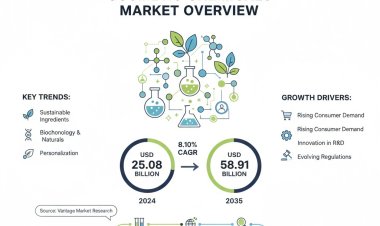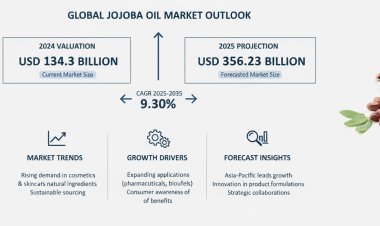Opioid Withdrawal Treatment Market Trends 2025: Insights & Forecasts
Discover key insights and future forecasts for the opioid withdrawal treatment market in 2025. Explore breakthrough therapies, digital health, and investment opportunities.

Opioid Withdrawal Treatment Market Trends 2025-2034: Key Insights and Future Forecasts
Natural health services and support programs represent a vital approach to combatting worldwide public health challenges stemming from the opioid crisis. Effective treatments to manage withdrawal symptoms and support long-term recovery remain essential because the opioid epidemic continues to change its nature. The pharmaceutical industry serving opioid withdrawal patients has experienced major progress because of revolutionary discoveries and administrative reforms and enhanced spending into research and development initiatives.
According to Vantage Market Research recent reports, the global opioid withdrawal treatment market size was 1.13 billion USD in 2023 and is projected to reach 1.24 billion USD in 2024. Market research indicates that the market will reach 3.26 billion USD in 2034, indicating a 10.1% increase over the forecast period (2025-2034).
Introduction
Opioid addiction has led to severe human death rates and created immense care system strain throughout the entire world. With millions of individuals suffering from opioid dependence, the demand for effective withdrawal treatments has surged. The pharmaceutical industry together with biotech firms along with healthcare providers allocate substantial financial resources to create new therapeutic approaches which both help minimize withdrawal effects and prevent patients from relapsing thus helping them maintain their recovery.
To learn more about this report - Request a Sample Report PDF

Understanding the Opioid Withdrawal Treatment Market
The Growing Need for Effective Treatment
The opioid epidemic has resulted in a substantial increase in the number of individuals seeking help for opioid withdrawal. Traditional treatment options, such as methadone and buprenorphine, have played a critical role in managing withdrawal symptoms. However, these treatments are not without limitations, including stigma, regulatory hurdles, and a one-size-fits-all approach that does not address the unique needs of every patient.
In recent years, the opioid withdrawal treatment market has expanded as research has uncovered new approaches that target both the physical and psychological aspects of withdrawal. These advancements are transforming the treatment landscape, offering patients more personalized and effective solutions.
Market Segmentation and Key Players
The market can be segmented into various categories based on treatment modalities:
- Pharmacological Interventions: This segment includes traditional opioid replacement therapies like methadone and buprenorphine, as well as emerging medications that target withdrawal symptoms with fewer side effects.
- Non-Pharmacological Therapies: Behavioral therapies, counseling, and digital therapeutics are increasingly being integrated into treatment plans. These therapies complement pharmacological interventions to provide holistic care.
- Combination Therapies: Combining medications with behavioral interventions is gaining popularity, as it can improve patient adherence and overall outcomes.
Major market players devote research funds to treatment innovation while extending their product offerings. The pharmaceutical companies along with biotech firms dedicate their efforts to create therapies which simultaneously tackle withdrawal symptoms and sustain treatment success and stop relapse.
Buy this Premium Research Report:– Purchase Now
Market Trends and Growth Drivers
Increasing Prevalence and Early Intervention
One of the primary drivers of the opioid withdrawal treatment market is the rising prevalence of opioid addiction. The growing number of people seeking treatment creates an increased requirement for developing early intervention methods. Quick diagnosis together with expedited medical care produces better treatment results which decreases disease recurrence and diminishes medical complications in long-term follow-up.
Technological Advancements and Innovation
Innovation is at the forefront of the market transformation. In 2025, technological advancements are expected to play a crucial role in shaping treatment modalities. Some key technological trends include:
- Novel Drug Formulations: New formulations are being developed to reduce withdrawal symptoms more effectively while minimizing side effects. These include extended-release formulations and drugs that target specific neural pathways involved in addiction.
- Digital Health Solutions: Modern patient recovery tracking benefits from digital health solutions which include mobile applications combined with wearable devices together with telemedicine platforms. Health technologies deliver live patient data as well as promote treatment compliance while enabling video consultations remotely.
- Personalized Medicine: The growth of biomarker-research together with genetic advances makes possible individualized medicinal approaches. Treatment efficacy can get improved and adverse effects can decrease through administering therapies that match patients' individual genetic-profiles.
Regulatory Approvals and R&D Investment
Regulatory authorities across the world are making their new treatment approval procedures more efficient which speeds up market entry. Increased investment in research and development (R&D) is driving the discovery of innovative therapies that address both withdrawal symptoms and long-term recovery. The strategic investments create an environment which builds competition between companies to provide state-of-the-art treatments to their patients.
Strategic Collaborations and Partnerships
The opioid withdrawal treatment market advances because pharmaceutical companies unite with academic institutions and technology providers through strategic partnerships. Partnerships enable groups to manage R&D risks through financial cooperation which creates faster progress for groundbreaking medicines. The combination of joint ventures successfully tackles regulatory hurdles while developing broader market distribution.
Emerging Trends in Opioid Withdrawal Treatment
Breakthrough Therapies
The market is witnessing growth in breakthrough therapies because pharmaceutical companies work on developing drugs that recognize the neurobiological causes of opioid addiction. The new therapy methods show better success rates in achieving long-term abstinence through more effective treatment of withdrawal symptoms. A unique transformation occurs in the market because traditional opioid replacement therapies transition towards modern advanced methods.
Digital Health and Telemedicine
Digital health solutions now change how we treat opioid withdrawal conditions. Telemedicine systems together with mobile medical applications help patients obtain healthcare services while allowing them to monitor their treatment activities and stick to prescribed medical protocols. The digital revolution produces better medical outcomes and eases healthcare center work by managing care outside facilities through monitoring and teleconsultation services.
Combination and Personalized Therapies
Future opioid withdrawal treatment will rely on therapeutic strategies which unite medicine-based approaches with non-drug methods. Biomarker analysis along with genetic research will establish personalized medicine as an essential treatment protocol by the year 2025. When treatment plans align with personal requirements doctors can achieve superior withdrawal symptom management and prevent patients from returning to drug use.
Browse in-depth TOC on "Global Opioid Withdrawal Treatment Market Size"
Future Forecast and Opportunities
Market Growth Projections
According to recent industry reports, the opioid withdrawal treatment market is projected to grow at a compound annual growth rate (CAGR) of around 10.01% through 2025. This growth is fueled by:
- The increasing prevalence of opioid addiction.
- The demand for innovative and personalized treatment options.
- Advancements in digital health and drug delivery systems.
- Supportive regulatory policies and increased R&D investments.
Opportunities for Stakeholders
The evolving landscape of opioid withdrawal treatment offers numerous opportunities:
- Pharmaceutical Companies: Companies that invest in innovative drug development and personalized medicine can capture significant market share.
- Biotech Startups: Emerging biotech firms have the opportunity to disrupt the market with breakthrough therapies and novel treatment formulations.
- Healthcare Providers: Providers can leverage digital health tools and telemedicine to offer improved patient care and expand their service reach.
- Investors: Investors now find promising investment avenues in the addiction treatment market because of its expanding scope.
Challenges to Overcome
Despite the promising outlook, several challenges persist:
- Regulatory Hurdles: Navigating the complex regulatory environment remains a significant barrier to market entry.
- High Treatment Costs: The cost of innovative treatments can be prohibitive, particularly for patients in low- and middle-income regions.
- Patient Adherence: Ensuring consistent patient adherence to treatment protocols is critical for achieving long-term success.
- Market Competition: Intense competition among established players and new entrants can lead to pricing pressures and market saturation.
Conclusion
The opioid withdrawal treatment market trends 2025 reflect a period of rapid innovation and dynamic growth. Opioid addiction prevalence together with advanced therapies and digital medicine innovations along with cooperative agreements create favorable conditions for market growth. Pharmaceutical companies together with biotech firms maintain their investment in research and development and personalized medicine which delivers promising treatment options to patients in the future.
For an in-depth analysis of market forecasts, key players, and regional trends, explore the detailed Opioid Withdrawal Treatment Market report by Vantage Market Research.


















